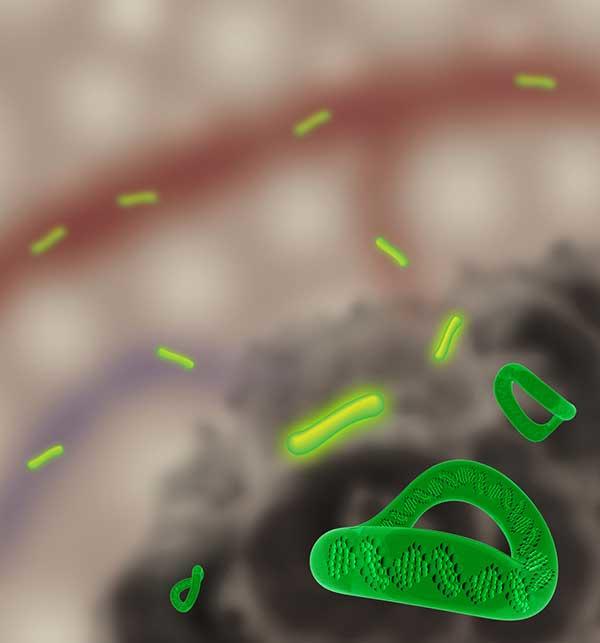DNA "Minicircles" Could Improve Cancer Detection, Study Suggests
, by NCI Staff
Injecting tiny customized DNA “rings” into tumor-bearing mice caused the tumor cells to release a detectable biomarker into the blood, according to a new study by researchers from the Stanford University School of Medicine.
The biomarker could be detected with a simple blood test as early as 48 hours after the mice were injected with the customized DNA rings, called DNA minicircles. Mice without tumors that were injected with the DNA minicircles did not have appreciable amounts of the biomarker in their blood. The proof-of-principle study was published February 23 in the Proceedings of the National Academy of Sciences.
Cancer researchers have long been interested in identifying biomarkers—biological molecules that provide accurate and sensitive information about the presence of cancer cells—for early detection and diagnosis of cancer. Although tumor cells naturally express certain proteins or secrete metabolic byproducts into the blood, these molecules are also often made in healthy tissues, limiting their usefulness as biomarkers for cancer detection and diagnosis.
To overcome this limitation, lead study author Sanjiv Gambhir, M.D., Ph.D., and his colleagues engineered DNA minicircles that cause cancer cells to make a protein that is naturally produced only in developing human embryos. Nonembryonic cells—cancerous or otherwise—do not normally make this protein. Once made, this biomarker, a protein called secreted embryonic alkaline phosphatase (SEAP), leaves the cells and enters the bloodstream.
DNA minicircles are artificial single-stranded rings of DNA about 4,000 nucleotides around. Cells readily take up DNA minicircles when they are mixed with a chemical agent. The minicircles created by the Stanford researchers contain a single gene that encodes SEAP, as well as a short DNA sequence called a promoter that controls whether, and how much, SEAP protein gets made in cells. The researchers used the promoter for a gene called survivin, which is expressed in cancer cells and embryonic tissue but not in healthy adult cells. So even though both tumor cells and normal cells can take up the DNA minicircles, only tumor cells that take up the minicircles can produce the SEAP protein.
The researchers compared the levels of SEAP in blood collected from two groups of mice that were injected with the DNA minicircles: one group of mice had tumors derived from human melanoma cells, and the other group was tumor-free.
Within 48 hours after the mice were injected with the DNA minicircles, SEAP levels were much higher in the blood of the mice with tumors than in the blood of the tumor-free mice. Moreover, among the tumor-bearing mice, those with larger or more tumors had more SEAP than mice with fewer or smaller tumors, suggesting that the DNA minicircle approach may also be a way to assess the extent of cancer, the researchers noted.
“Pancreatic and ovarian cancers are typically detected very late, when the prognosis is poor,” said Sudhir Srivastava, Ph.D., chief of the Cancer Biomarkers Research Group at NCI. “This technology could be used to amplify signals from cancer cells and enable early detection of these cancers. Of course, the DNA minicircles would first have to be tested and regulated for use in humans, but the technology is very promising.”
